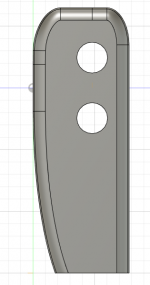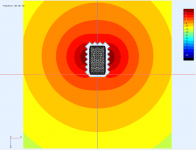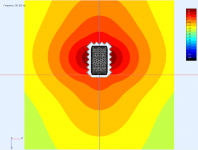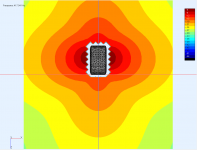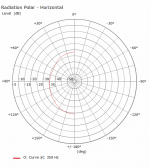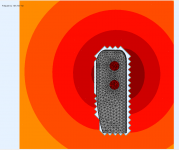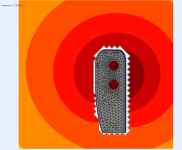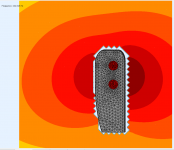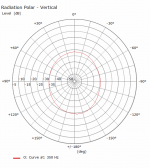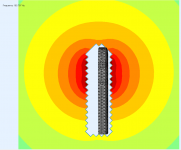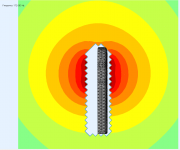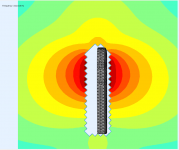A post from kimmosto on ASR got me thinking about vertical directivity. I am now more convinced that the reason I like my line array more over a wider range of music than any other speakers I have tried is due to the vertical directivity response.
https://www.audiosciencereview.com/forum/index.php?threads/some-help-with-lobing.22661/post-755427
I've done huge vertical directivity, so the last option on the list a coaxial mid tweeter got my interest.
Originally I planned for the coax to sit in between 4 woofers in a symmetric array somewhat like the perlisten tower speakers in layout. Maybe that is what will eventuate but all the interest in Kef speakers and the LS60 got me thinking. Is a Blade like arrangement of woofers a good idea. Having the reaction force of the woofers balanced and placing them close together as a virtual point source sounds good.
The drivers I have are from Sica as they were available at a good price and I have been happy with the build quality for the price on some other drivers of theirs I bought previously.
The 6.5" coaxial was chosen as visual match to the 6.5" woofers and there is something about the response that looks it will be easier to cross together.
A German project using the coaxial is here
https://www.diy-hifi-forum.eu/forum...e-Sica-5-5-und-6-5-Zoll-Coaxe-mit-Kalotten-HT
The woofers here
http://www.donhighend.de/?page_id=5291
I had been 3D modelling ideas in Fusion with inspiration from the TAD Evolution 1 speaker in mind. So this is somewhat of a small love child between that and the Blade.
The name comes from the side shape of the front baffle which is much the same as a Tachi blade.

https://www.audiosciencereview.com/forum/index.php?threads/some-help-with-lobing.22661/post-755427
I've done huge vertical directivity, so the last option on the list a coaxial mid tweeter got my interest.
Originally I planned for the coax to sit in between 4 woofers in a symmetric array somewhat like the perlisten tower speakers in layout. Maybe that is what will eventuate but all the interest in Kef speakers and the LS60 got me thinking. Is a Blade like arrangement of woofers a good idea. Having the reaction force of the woofers balanced and placing them close together as a virtual point source sounds good.
The drivers I have are from Sica as they were available at a good price and I have been happy with the build quality for the price on some other drivers of theirs I bought previously.
The 6.5" coaxial was chosen as visual match to the 6.5" woofers and there is something about the response that looks it will be easier to cross together.
A German project using the coaxial is here
https://www.diy-hifi-forum.eu/forum...e-Sica-5-5-und-6-5-Zoll-Coaxe-mit-Kalotten-HT
The woofers here
http://www.donhighend.de/?page_id=5291
I had been 3D modelling ideas in Fusion with inspiration from the TAD Evolution 1 speaker in mind. So this is somewhat of a small love child between that and the Blade.
The name comes from the side shape of the front baffle which is much the same as a Tachi blade.
Attachments
I have been getting the hang of AKABAK so these simulations where done with that instead of ABEC.
Horizontal directivity in a traditional polar plot and field views, I was aiming for a 350Hz crossover but things but there is more lobing than I thought there would be
Horizontal directivity in a traditional polar plot and field views, I was aiming for a 350Hz crossover but things but there is more lobing than I thought there would be
Attachments
I've done huge vertical directivity, so the last option on the list a coaxial mid tweeter got my interest.
Are you expecting that the cone driver behind the tweeter will act as a quasi-waveguide? My thought is that most coax's do not position the tweeter properly in the cone, and the shape of the cone is not quite correct. KEF is probably the exception. I am very interested in your thoughts...
j.
The cone in front of the tweeter does act as a waveguide. KEF, Genelec and TAD have the best coaxial driver implementations and patents certainly restrict the wide availability of their methods to many generic drivers.
The junction between the cone and tweeter is tricky and will likely always present in some sub optimal way. In general with the better drivers it creates a less than ideal on axis response but once off that specific axis everything settles down. This is somewhat similar to balancing the on and off axis diffraction response of a sub optimal baffle. It becomes a matter of finding the best balance.
The Sica coaxes are different to KEF's, the cone is more curvilinear and there is a small plastic waveguide lip. The cone is paper and the dome textile.
The ideal waveguide contour does not necessarily make the best woofer contour so there is a compromise, the latest KEF cones seem to have targeted a flat DI, the Sica looks to have more of a rising DI particularly at the top end. When the woofer is in the the 4 to 6.5" range there seems to be reasonable compromise to be had.
I have read and heard enough good reports of the Sica coaxes to give them a try and see for myself.
The next move for this project will be to simulate the difference with the woofer drivers in a vertical line to see which direction to move in. I knew there would be more side and rear output from the opposed mounting of the woofers but the more I look at the directivity the less I like it.
The junction between the cone and tweeter is tricky and will likely always present in some sub optimal way. In general with the better drivers it creates a less than ideal on axis response but once off that specific axis everything settles down. This is somewhat similar to balancing the on and off axis diffraction response of a sub optimal baffle. It becomes a matter of finding the best balance.
The Sica coaxes are different to KEF's, the cone is more curvilinear and there is a small plastic waveguide lip. The cone is paper and the dome textile.
The ideal waveguide contour does not necessarily make the best woofer contour so there is a compromise, the latest KEF cones seem to have targeted a flat DI, the Sica looks to have more of a rising DI particularly at the top end. When the woofer is in the the 4 to 6.5" range there seems to be reasonable compromise to be had.
I have read and heard enough good reports of the Sica coaxes to give them a try and see for myself.
The next move for this project will be to simulate the difference with the woofer drivers in a vertical line to see which direction to move in. I knew there would be more side and rear output from the opposed mounting of the woofers but the more I look at the directivity the less I like it.
Hi Fluid.
With Blade it seems they decided to handle diffraction issue with less consideration for directivity behavior of low mids.
I've played a bit with push/push and there is benefits from force cancellation. But i wonder up to which freq it is interesting? I remember W.Parham told for sub and low range it is worth it ( even push/pull) but once you want to climb in freq his thoughts was demodulation rings broughts other more noticable benefits.
I wonder if it is not same case with this arrangement: up to 250/300hz it's ok ( better if kept below 200hz) but higher and compromise on directivity start to show up so another answer have to be fund imo like an other set of drivers...
Coax seems to be always 'shorter' on extension one way or another with low end it seems...
With Blade it seems they decided to handle diffraction issue with less consideration for directivity behavior of low mids.
I've played a bit with push/push and there is benefits from force cancellation. But i wonder up to which freq it is interesting? I remember W.Parham told for sub and low range it is worth it ( even push/pull) but once you want to climb in freq his thoughts was demodulation rings broughts other more noticable benefits.
I wonder if it is not same case with this arrangement: up to 250/300hz it's ok ( better if kept below 200hz) but higher and compromise on directivity start to show up so another answer have to be fund imo like an other set of drivers...
Coax seems to be always 'shorter' on extension one way or another with low end it seems...
Blade is different in a few ways, not least the size of the side drivers which I think are about 9 inches each. This would make a wide front cabinet if they were not on the sides which is not as popular with the home decor types.
If they can be placed further away from the wall behind then the force cancellation benefits might win, needing a nearer wall placement, less rear energy might work better. Maybe vertically symmetric making the outer drivers more of a .5 will work. A few possibilities to simulate through. I probably need to adjust the side driver version to move them in towards the front as the lobing started earlier than I hoped for.
If they can be placed further away from the wall behind then the force cancellation benefits might win, needing a nearer wall placement, less rear energy might work better. Maybe vertically symmetric making the outer drivers more of a .5 will work. A few possibilities to simulate through. I probably need to adjust the side driver version to move them in towards the front as the lobing started earlier than I hoped for.
I just used an online calculator and it tells me 78Hz, which means I need moar bigger speakers!!!I understand that the current trend is to control directivity to as low a frequency as possible, but does it really have any real-world effect below the Schroeder frequency, which for most rooms is 200 - 300 Hz?
I've tried a delayed inverted rear woofer for cardioid-like response, cancelling the rear directed energy. If you can accomplish that with a rear resistance vent, you've got something. I get a lot better side and rear attenuation modelling side resistance vents on W-Coax-W.Blade is different in a few ways, not least the size of the side drivers which I think are about 9 inches each. This would make a wide front cabinet if they were not on the sides which is not as popular with the home decor types.
If they can be placed further away from the wall behind then the force cancellation benefits might win, needing a nearer wall placement, less rear energy might work better. Maybe vertically symmetric making the outer drivers more of a .5 will work. A few possibilities to simulate through. I probably need to adjust the side driver version to move them in towards the front as the lobing started earlier than I hoped for.
After more thought, I suppose it does have an effect. Dipole bass certainly sounds different than omnipole bass (open baffle vs sealed box for instance), and the biggest difference between the two is directivity at low frequencies...I understand that the current trend is to control directivity to as low a frequency as possible, but does it really have any real-world effect below the Schroeder frequency, which for most rooms is 200 - 300 Hz?
Nc535,
You modeled side vents under which software?
What was your feelings about the inverted delayed cardio?
HifiJim,
Some members experienced directivity control below Schroeder freq. And it seems there is mixed feelings: Cask05 think it make a huge difference, Mark100 thoughts it is nice but not something to write books about...
Fluid,
Yes esthetic is high on design criteria in Kef's whitepapers. I wonder if they would have made same choices if they focused only on performance?
You modeled side vents under which software?
What was your feelings about the inverted delayed cardio?
HifiJim,
Some members experienced directivity control below Schroeder freq. And it seems there is mixed feelings: Cask05 think it make a huge difference, Mark100 thoughts it is nice but not something to write books about...
Fluid,
Yes esthetic is high on design criteria in Kef's whitepapers. I wonder if they would have made same choices if they focused only on performance?
Last edited:
After more thought, I suppose it does have an effect. Dipole bass certainly sounds different than omnipole bass (open baffle vs sealed box for instance), and the biggest difference between the two is directivity at low frequencies...
I'd say that one of the differences also is relation between cone surface and cabinet surface. Difference is so extreme that it is questionable what would prevail in subjective domain if we would use two closed box woofers back to back and compare it to OB woofer - properly equalized to achieve similar frequency response at the listening spot, of course.
My main concern is the 200 to 500Hz region where SBIR is difficult to control and it is the shape of the directivity I am not taken with. More rear and side output is not what I want here.I understand that the current trend is to control directivity to as low a frequency as possible, but does it really have any real-world effect below the Schroeder frequency, which for most rooms is 200 - 300 Hz?
There are differences for sure and the room the speaker is in will have a big effect on what might be the best strategy. In an untreated room with compromised positioning full range cardioid makes more sense. There are other differences between dipole and monopole not least the need for huge excursion in a dipole trying to make low bass.After more thought, I suppose it does have an effect. Dipole bass certainly sounds different than omnipole bass (open baffle vs sealed box for instance), and the biggest difference between the two is directivity at low frequencies...
Getting any real directivity low in frequency is either going to be very big or very inefficient. Neither of those things are design targets here 🙂
I originally wanted this design to not be overly complicated, if the vertical array simulations are no more encouraging than the current ones are, then that might have to be scratched. I could include another way and use the 5" drivers I have on the side (or an angled baffle extension) and the 6.5" drivers on the back, like a stretched Kii with a coax MT.I've tried a delayed inverted rear woofer for cardioid-like response, cancelling the rear directed energy. If you can accomplish that with a rear resistance vent, you've got something. I get a lot better side and rear attenuation modelling side resistance vents on W-Coax-W.
Probably not but the Blade is not lacking in performance overall, more like different than better or worse. The Muon shows how hard it is to combine large and small drivers on the front without things starting to look too different.Yes esthetic is high on design criteria in Kef's whitepapers. I wonder if they would have made same choices if they focused only on performance?
My simulations have been done in Vituix with diffraction tool generated directivity for the woofers. For the coax, I've been using the NFS generated files posted by Amir of ASR in his review of the KEF R3. The R3 curves are only valid here when I cross over to the woofers at 450 Hz as is done in the R3. Were I to post these results, the polars would look quite good. On close examination though the directivity the cardioid features add isn't high - its about a DI of 5. If you are looking at cardioid to reduce SBIR you will be disappointed. Its quite effective vs front wall reflections but at best reduces the dips from the other surfaces by a couple of db. What you do get for the extra complexity however, is reduced energy out to the sides and rear and the ability by playing with the attenuation and delay to the inverted side or rear drivers and overlap with the coax mid, are text book smoothly falling power response and PIR curves. I go back and forth between prizing the simplicity of the non-cardioid blade design and feeling I owe it to myself to include at least a rear woofer so I can experiment with cardioid.
Just keep drivers closer than the wavelength divided by 8 to wall behind speakers and SBIR from that wall is only constructive!🙂My main concern is the 200 to 500Hz region where SBIR is difficult to control and it is the shape of the directivity I am not taken with. More rear and side output is not what I want here.
Its hard because modest attenuation towards the back (front wall), or boost for that matter, does practically nothing to the interference. To significantly affect the resulting nulls and peaks, to have them "only" +/-3db for example one needs ~10db of attenuation towards the wall (or 10db attenuation between direct and reflected sound). To get into "good loudspeaker anechoic response" territory, response within +/-1db, the attenuation needs to be ~20db.
Liberating info for the system you've simulated is that inspecting interference in the low mids it doesn't matter too much which one is louder the reflected or direct sound the interference is still about the same because it is solely from the path length difference and relation of the SPL so if speaker outputs 90db towards listening position and 87db towards the wall, or vice versa, the resulting interference is about the same. There is some difference on how deep the nulls are depending how far out the speaker is from the wall but the interference is still quite bad both cases. Increased path length through the wall attenuates sound teeny bit, perhaps a db, so there is some advantage to have more frontal sound than towards back. Interference is worst when both interfering sounds are equally loud and lessens if either is attenuated, doesn't matter which.
You could have the speaker at the wall below frequencies when wavelength is 8 times the depth of your system and controlled directivity above. In practice control directivity down to somewhere 200Hz or so and you are into room dominating territory or ~20cm depth for your bass box depending how you wanna play the game. Problem is that its only one of the six walls of a cubicle that is relieved 🙂 For speakers that are ment to be positioned in room, further from walls, any attenuation towards any wall is good but as you say requires big system to get enough attenuation to significantly affect the resulting comb filter. Wanna small? go close to wall.
Last edited:
Had to try it quick to make sure how it plays out.
In fact the further out a speaker is into the room the more it pays off to have frontal sound louder than to the back towards the front wall behind speakers. This is because the round trip through the wall is so long there is already some significant attenuation on the reflection due to path length alone and if radiation towards wall was stronger than towards listening position this SPL difference effectively evens out making about worst interference.
This is just to illustrate what the relative levels / distances could be and how things could play out regarding SBIR and does not include influence of room at low frequencies for example.
Here example with ideal sound source ~1m into room so that reflected sound from front wall has ~2m longer path length to listening position makes already ~4db attenuation (excluding effects of room) and resulting comb is only total ~10db:
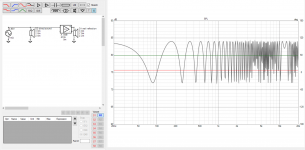
If signal towards the wall was 3db louder than towards listening position the ~4db attenuation is now reduced to just ~1db and about worst possible comb filter effect happens:
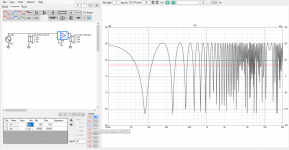
When sound towards listening position is 3db louder than towards the wall reflection point the total attenuation (or SPL difference) is now ~7db and resulting interference is only ~8db.
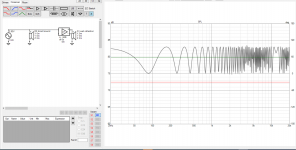
Better, but quite bad still 🙂
In fact the further out a speaker is into the room the more it pays off to have frontal sound louder than to the back towards the front wall behind speakers. This is because the round trip through the wall is so long there is already some significant attenuation on the reflection due to path length alone and if radiation towards wall was stronger than towards listening position this SPL difference effectively evens out making about worst interference.
This is just to illustrate what the relative levels / distances could be and how things could play out regarding SBIR and does not include influence of room at low frequencies for example.
Here example with ideal sound source ~1m into room so that reflected sound from front wall has ~2m longer path length to listening position makes already ~4db attenuation (excluding effects of room) and resulting comb is only total ~10db:

If signal towards the wall was 3db louder than towards listening position the ~4db attenuation is now reduced to just ~1db and about worst possible comb filter effect happens:

When sound towards listening position is 3db louder than towards the wall reflection point the total attenuation (or SPL difference) is now ~7db and resulting interference is only ~8db.

Better, but quite bad still 🙂
Last edited:
This is pretty much what you get with having the drivers on the side about 3dB more to the sides than the front or rear which is why I am not particularly taken with the directivity pattern it generates.If signal towards the wall was 3db louder than towards listening position the ~4db attenuation is now reduced to just ~1db and about worst possible comb filter effect happens:
View attachment 1063694
- Home
- Loudspeakers
- Multi-Way
- Tachi - Coaxial Point Source BEM modelling

